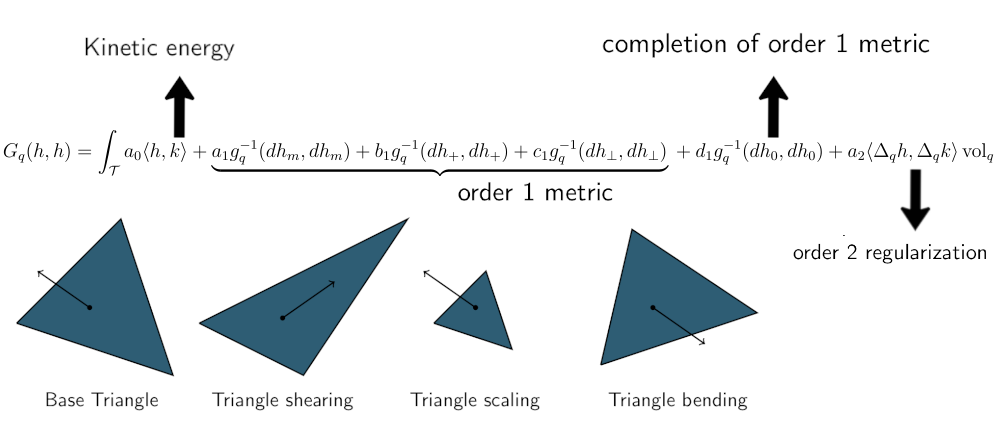BaRe-ESA: A Riemannian Framework for Unregistered Human Body Shapes
Published in International Conference on Computer Vision (ICCV), 2023
Emmanuel Hartman, Emery Pierson, Martin Bauer, Nicolas Charon, Mohamed Daoudi
We present Basis Restricted Elastic Shape Analysis (BaRe-ESA), a novel Riemannian framework for human body scan representation, interpolation and extrapolation. BaRe-ESA operates directly on unregistered meshes, i.e., without the need to establish prior point to point correspondences or to assume a consistent mesh structure. Our method relies on a latent space representation, which is equipped with a Riemannian (non-Euclidean) metric associated to an invariant higher-order metric on the space of surfaces. Experimental results on the FAUST and DFAUST datasets show that BaRe-ESA brings significant improvements with respect to previous solutions in terms of shape registration, interpolation and extrapolation. The efficiency and strength of our model is further demonstrated in applications such as motion transfer and random generation of body shape and pose.
Model

Our human shape space is defined as :
\[\operatorname{Imm}=\left\{ q\in C^{\infty}(\mathcal{T},\mathbb R^3): Tq \text{ is inj.}\right\}\]We define a linear Latent space, define as \({\mathcal L}\subset \mathbb R^{n+m}\), with latent vectors \(\alpha\) of human shapes:
\[F(\alpha^j)=\bar q+\sum_{i=1}^m \alpha^j_i h_i+\sum_{i=m+1}^{m+n} \alpha^j_i k_{i-m},\]where \(\{h_i\}_{i=1}^{m}\) and \(\{k_i\}_{i=1}^n\) are shape and motion basis.
We equipe our latent space with a Riemannian metric:
\[\overline{G}_{\alpha}(\beta,\eta):= G_{F(\alpha)}(F(\beta )-\overline{q},F(\eta )-\overline{q}).,\]where \(G\) is a weighted Sobolev metric on \(\operatorname{Imm}\) [Hartman et al. 2022].
It has 6 terms, defined as follow:

Where \(a_0, a_1, b_1, c_1, d_1, a_2\) are the metric parameters, set to \(1, 1000, 100, 1, 1, 1\) in this work (penalizing non isometric deformations).
Using this framework, we define interpolation between two shapes \(q_0\) and \(q_1\) as the path \(\alpha(t)\), minimizer of the following energy:
\[\tilde E(\alpha)= \int_0^1 \overline{G}_{\alpha}(\partial_t\alpha,\partial_t\alpha) dt +\lambda \Gamma(F(\alpha)(0),q_0)+\lambda \Gamma(F(\alpha)(1),q_1),\]where \(\Gamma\) is the varifold [Charon et al. 2013] discrepancy metric, and is equal to 0 when both \(\alpha(i)\) and $q_i$ are reparameterization of each other. This allows to work with unparameterized human shapes.
We can also define extrapolation of the motion of \(q_0\) with inital velocity \(h = q_1 - q_0\) as the solution of the equation:
\[\begin{cases} q(0)&=q_0\\ \partial_t q(0)&=h \end{cases},\]We solve this equation using a Gauss-Newton scheme (details in the paper).
Video
Results (registration)

Results (interpolation)


Applications


Acknowledgements
This work was supported by ANR projects 16-IDEX-0004 (ULNE) and by ANR-19-CE23-0020 (Human4D); by NSF grants DMS-1912037, DMS-1953244, DMS-1945224 and DMS-1953267, and by FWF grant FWF-P 35813-N. The training of all methods for the experiments presented in this paper were carried out using the Grid’5000 testbed, supported by a scientific interest group hosted by Inria and including CNRS, RENATER and several Universities as well as other organizations (see https://www.grid5000.fr).
Citation
@inproceedings{hartman2023bare,
title={Bare-esa: A riemannian framework for unregistered human body shapes},
author={Hartman, Emmanuel and Pierson, Emery and Bauer, Martin and Charon, Nicolas and Daoudi, Mohamed},
booktitle={Proceedings of the IEEE/CVF International Conference on Computer Vision},
pages={14181--14191},
year={2023}
}
This webpage was inspired by Nerfies.